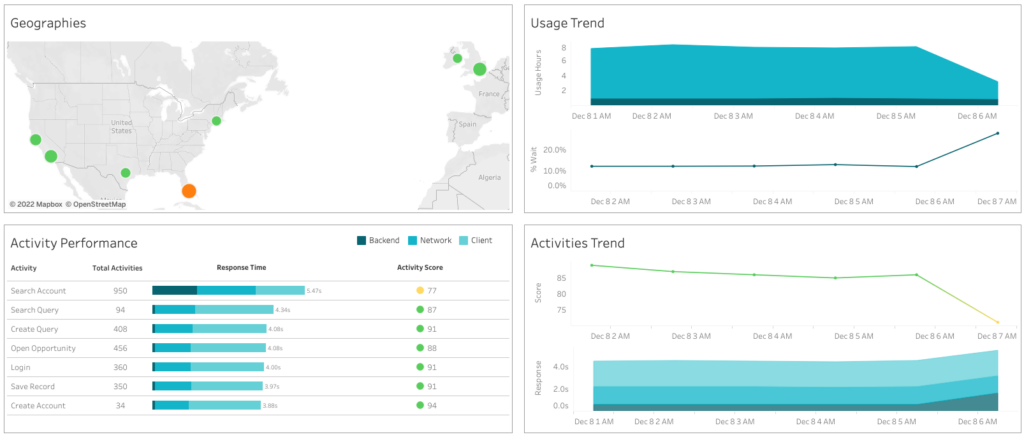In my last blog article, I drew the comparison between the engine warning light in a car and IT monitoring. But what does that mean in detail? An excellent example is Digital Employee Experience (DEX): This is the warning light that indicates whether IT users are happy with IT or whether there are problems. Most of the time, the biggest dissatisfaction does not come from the fact that the device used is too slow. Most users are not IT experts. They expect a working environment to function as they know it from their computer at home. Designed digitized work processes must be put into use without a great deal of learning effort, and more importantly–that must work.
What is Digital Employee Experience (DEX)?
Companies use email surveys to learn how users feel about their IT services. As the digitalization of many work processes makes IT increasingly important, it is mandatory for IT to perform well in these surveys. However, surveys are only ever a snapshot, which makes monitoring the Digital Employee Experience (DEX) increasingly important.
In these situations, the user’s experience is directly measured on the device itself (for example, a laptop or desktop). The focus is not on checking whether the end device is technically busy or functioning properly. The question is whether users can work fluidly with the applications. It should also be analyzed whether digitized work processes in the applications are perhaps too cumbersome or simply take too long.
Make workflows and digitized work processes visible

At my bank this year, I experienced firsthand what it means when workflows in applications are broken. In my case, it took far too long: I actually just wanted to open a depot for my daughter so that I could regularly save for an ETF fund. Our bank has digitized the entire process so that all compliance aspects are met, and the bank advisor doesn’t forget a single point.
One would think that opening a depot should therefore be quick. However, the system had several problems:
Since my daughter is still a minor, permission from my wife and me had to be entered beforehand. This meant that our bank advisor had to fill out additional forms digitally. This sounds easier than it was, as something didn’t work in almost every form or took an extremely long time to save. In the end, I was at the bank for over an hour to open a simple depot.
Why is a broken workflow not only an IT issue?
Now, looking at this experience in more detail, some problems are obvious:
- Very few customers are willing to wait that long and might consider switching banks next time.
- Faulty workflows or processes don’t just put a strain on IT. Our bank advisor was more than uncomfortable that this didn’t work and she had to apologize to the customer.
- Digitization should simplify processes and accelerate them, especially in times of a shortage of skilled workers. The goal should be to enable existing employees to do their jobs better and faster. If this isn’t taken into account, productivity will decrease as a result of digitization instead of continuing to rise.
- Since internal support processes sometimes take a very long time, the relevant IT employees or application managers are notified of these problems far too late. Often, support tickets are no longer opened because the employee concerned does not have the time.
Making workflows technically visible
In our Riverbed portfolio, there are two products that can make workflows visible:
Riverbed Aternity is suitable for any type of application (e.g. a classic application or web application) used by employees:
Riverbed UJI (User Journey Intelligence) is a solution for web applications that helps you understand how people (both internal and external) use them:
In principle, Riverbed can therefore make workflows visible from any application. In the simplest case, for example, it monitors how long it takes to open the calendar in Microsoft Outlook. The example with my bank is a complex case where several pieces of information from a workflow need to be monitored. An error message is displayed, for example, showing “Form A” has been used and how the user got into this form. At the same time, it is also possible to record how long it takes to save the form.

An important aspect is that the measurements provide context to technical elements in order to determine where a fault lies, if any. Not every problem is due to a problem in the application. IT has become so complex that the end device itself, the network or components in the data center/cloud can also be the cause of a poor experience. That’s why Riverbed combines experience and workflow data with technical data from different perspectives.
EMA Value Leader 2022

In light of this, EMA has ranked us as a Value Leader in the EMA Radar for Digital Employee Experience this year (2022).
If you like what you see and want to try it out for yourself, you can download a free trial here to experience it firsthand. Talk to us if you have any questions!
